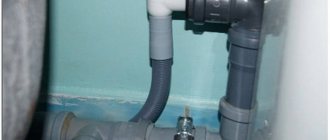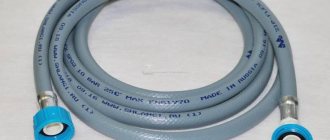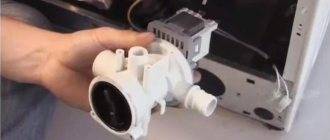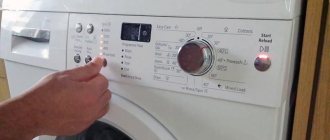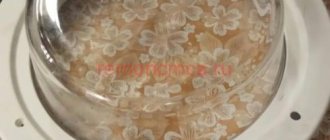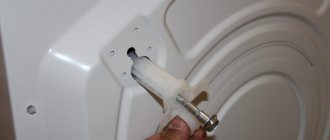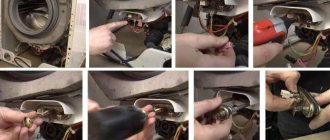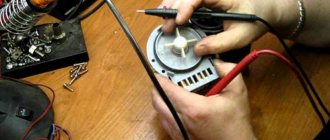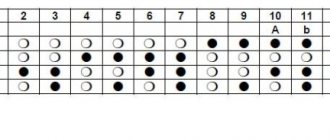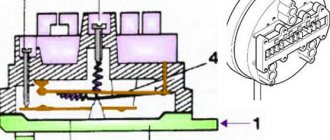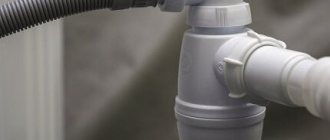Drain hose
The simplest method allows you to drain the water the fastest. Procedure:
- Turn off the power, turn off the water supply.
- Disconnect the drain hose from the rear panel.
- Pull the outlet out of the sewer pipe.
- Place the end of the hose in a container (bowl or basin) located below the level of the washing tank. The container required is low; it is difficult to pour into a bucket using this method.
If the washing machine does not drain water in this way, then it is equipped with protection against leakage from the sewer hose.
Inside the housing, manufacturers make an additional loop with a drain hose or install a plastic elbow, so the drain hose is always above the level of the tank. Most often found in Bosh and Siemens washing machines. See also -
Samsung washing machine fault codes
How to connect a machine without using a siphon
Making a direct connection to the sewer is not difficult, the main thing is to use a tee and follow all the height rules. A tee with a diameter of 50 mm is installed in the socket of a plastic sewer pipe.
A plastic or polyethylene tee is mounted as follows:
- first you need to remove the old siphon;
- then insert the adapter;
- after this the tee itself is installed.
Sometimes it is necessary to use an additional plastic tube to connect to the sewer drain. How to connect the drainage system directly to the sewer?
Installing such a drainage system in the bathroom is easy:
- first you need to lower the hose into the pipe;
- then fix;
- and then connect hermetically.
If the connection is not airtight, sewer odors will enter the room.
It is not for nothing that the back cover of the washing machine is equipped with a special fastener for the hose, which is located much higher than the area from which the hose comes out. If it is in the correct position, even when the pump is turned off, dirty water does not flow back into the machine. If the cover does not have such fastening, you should make an S-shaped bend of the hose yourself.
Connecting the washing machine drain to the sewer.
It is worth noting that a straight hose can always lead to the backflow of dirty water, and even well-washed clothes can “smell” with sewer odors. This is why it is so important to position the hose correctly. The adapter is used to improve sealing.
By the way, the same actions are performed when a hose needs to be replaced. Then the back cover is removed and the hose to which the drain pump is connected is replaced. Some washing machines are designed in such a way that when replacing the drain hose, the top cover of the machine must also be removed, which is put back in place after replacing the hose.
Emergency hose
Designed specifically for draining water in case of breakdown. It is usually located in a special hatch at the bottom of the front panel and is closed by a small door, where the drain filter is also located. In some cases, the drain mechanism is implemented in the form of a retractable plastic channel. If you do not see the hatch on the front panel, then it is located under the plastic decorative panel at the very bottom. This design is found in Indesit washing machines.
Draining order:
- Open the hatch door and remove the thin emergency hose from the niche.
- Place a flat, wide container of suitable height under the hatch. Remove the plug from the hose and place it with the outlet hole in the container.
- Monitor the process so that the water does not spill.
Important:
all procedures for draining water are carried out only after disconnecting the washing machine from the electrical network and water supply!
Disadvantages of the method:
- Long draining process – up to 30 minutes;
- The emergency hose is often clogged with scale or other debris, so the water will not drain;
- Some models do not have an emergency hose.
Advice:
To speed up the process, tilt the machine against the wall, open the drum hatch, and scoop out some of the water by hand. We drain the remaining water through the emergency hose.
How to forcefully drain water from a washing machine
First of all, you should try to restart the program. In addition, recently modern machines have begun to be equipped with an additional forced drain option, so the first thing to do is to enable it. If all else fails, then you should prepare to drain the water manually: disconnect the machine from the power supply and turn off the water.
Water can remain inside not only in a situation where the machine breaks down, but also for other reasons. It must be borne in mind that most often this procedure is accompanied by the release of a significant amount of liquid onto the floor. Therefore, it is advisable to find a basin and rags in advance and clean the space next to the machine so that nothing interferes with dealing with the problem.
Manufacturers produce high-quality models, however, breakdowns sometimes occur, and at the most inopportune moment.
Drain filter
It is located together with the emergency hose, which we wrote about above. Designed specifically to protect the pump from debris, small objects, and lint from clothing. Cleaning the drain filter is the simplest and most common solution to the problem.
Procedure:
- Open the hatch cover at the bottom. Sometimes the hatch door can be covered with a narrow decorative panel at the bottom of the washing machine.
- Tilt the housing towards the rear panel so that you can install a low basin under the filter to collect water. For convenience, you can lean the washing machine against the wall. If the tilt is too high, the rear legs may start to slide on the tiles, be careful.
- Turn the drain filter clockwise by the handle. To adjust the pressure of the drained water, you do not need to unscrew it all the way.
- Keep the machine tilted until water stops flowing into the container. At the end of the drain, you will have to return the device to its normal position, and then collect the remaining water manually.
Advice:
Prepare in advance by laying out rags or towels, this will make cleaning easier after draining the water.
Bail out water by hand
The most obvious and easiest way to drain water is to manually scoop it out of the washing machine through the drum hatch.
Disadvantages of the method:
- You won't be able to drain all the water. As a result, the remaining water will have to be drained using a drain filter or emergency hose.
- Long and inconvenient. Especially when compared with the first method.
- Sequencing:
- Open the washing tub door. A car with a front hatch will have to be tilted towards the rear wall to prevent water from spilling onto the floor. This is not required for vertical loading.
- After taking out the laundry, scoop out the remaining liquid with a ladle or mug.
- Return the machine to its normal position. Some of the water will remain in the hose system located below the tank.
Important:
Modern machines are equipped with a door lock with a timer and open 5 to 10 minutes after turning off. If the hatch is jammed, special emergency unlocking methods are used.
Reasons why water remains in the washing machine tank
The weight of the laundry exceeds the norm
The technical data sheet of each washing unit indicates the maximum load rate of laundry. In addition, each mode also provides such an indicator. Often, housewives neglect this condition and laundry ends up in the drum in excess of the norm. At the same time, the water level sensor does not correctly determine the water level in the tank, considering it below normal. As a result, the control module does not give a command to drain the liquid, the drain pump does not turn on and draining is not performed. To eliminate the failure, you need to select the “pause” mode (for units with top loading), wait for the hatch to unlock, remove some of the laundry and continue washing.
Program selection error
There are washing programs in which water drainage is not provided. For example, at the end of the “WOOL” mode, the water does not drain, and this is completely normal. It is necessary to take out the laundry, turn on the “DRAIN” mode and remove the liquid from the tank. Modern washing units are electronic-mechanical devices capable of performing independent diagnostics and notifying about malfunctions. The main method is to display information on the device display in the form of error codes.
- Indesit, Ariston – F05, F11
- Electrolux, Zanussi – EF1
- LG-OE
- Samsung – E02
- Bosch, Siemens – F18, d02, d03
- Whirlpool – F03
- Beko-H5
Drain system contamination
Water may also not drain if there is a clog in any part of the drain system. The principle “from simple to complex” is suitable for testing. First, you can check the drain hose and sewer system; if there is water in the sewer drain, you need to call a plumber for help. Next, check the filter located below next to the pump; if it is clogged, clean it of debris. If the above is in order, then we move on to checking the rubber pipes through which the liquid passes; usually debris accumulates in them or a foreign object accidentally gets in.
Drain pump faulty
The operation of the drain pump can be determined by its characteristic sound. If there is water in the tank and the pump does not start in drain mode, one of the reasons may be a malfunction of the pump electric motor. To determine the malfunction, the pump should be removed and using a tester, check the motor winding for breaks and short circuits. Most often, pumps do not have a dismountable design, and if they break down, the entire pump assembly is replaced.
The water level sensor is faulty
Incorrect operation of the pressure switch can result in incorrect information about the water level in the washing tank being sent to the electronic unit. The machine “believes” that there is not enough liquid or no liquid at all, and the drain does not occur. A blockage in the tube connecting the sensor to the washing tub can also cause the sensor to malfunction. To clean, you need to remove the top cover of the unit, disconnect the tube and remove the blockage. If, when checking the sensor, it turns out that it is faulty, it is also replaced entirely.
Control module is faulty
The reason for the lack of drainage may be software failures or failure of electronic components. In this case, repairs must be carried out by a qualified technician using the necessary equipment and accessories.
The heating element does not work
If the machine does not drain water during the rinse mode and displays an error message that stops washing, the heating element may be faulty. On Ariston units, a malfunction is indicated by all the lights flashing orange in an emergency. After replacing the heating element, the washing machine operates as usual.
Attention! Troubleshooting should only be done when the device is de-energized.
Drain pipe
This method is used to remove water and repair faults. If, when you unscrew the drain filter and clean it, water does not flow out, there is a blockage inside the drain pipe. You can find this corrugated thick hose yourself using the diagram from the instructions for your washing machine. Most often located at the bottom of the rear of the washing machine.
Procedure to clear the blockage:
- Remove the back panel, secured with 4 screws.
- Place a water container on the floor under the pipe or cover the floor with towels. Depending on the location of the pipe and pump, the machine will have to be tilted or even placed on its side. Therefore, act according to the circumstances; it may make sense to first drain the water in another way, and then start clearing the blockage.
- Disconnect the pipe from the pump by carefully removing the clamp (scroll).
- If the liquid does not go away, you will have to forcefully clear the blockage. This can be done with your fingers, a pencil, a screwdriver, or using a soft wire hook.
- Did not help? There is another option, unscrew the pipe from the tank and thoroughly clean it.
- After cleaning and draining the water, return all parts of the mechanism to their place and securely fasten them. Check for leaks. Connect the device to the power supply, open the water supply tap from the water supply.
- Close the back panel.
Having done some simple repairs, the problem will most likely be eliminated. Run a test wash without any laundry and check the drainage.
How to drain water from a washing machine directly
If no other method helps, the only solution left is to open the door. It is clear that a significant amount of water will spill on the floor, so it is necessary to prepare in advance and quickly neutralize it.
To reduce spills, it makes sense to back the machine so that the front panel is at an angle to the floor surface. After opening the door, you need to scoop out the water with a small mug or small ladle. However, it will not be possible to completely remove it.
You can drain the water this way only if the door is not locked.
